Microstructural and Textural Evolution in Hexagonal Close-Packed Metals: The Case of Zirconium, Magnesium, and Titanium
Abstract
:1. Introduction
2. Deformed Microstructure and Texture in Zirconium
2.1. Role of Plastic Anisotropy during Deformation
2.2. Effect of Temperature and Orientation on Microstructure Development

2.3. Effect of Temperature and Orientation on Texture Development
2.4. Microstructure and Texture Development during Pilgering
2.5. Grain Fragmentation during Deformation
2.6. Crystallographic Texture Evolution during Rolling and Annealing
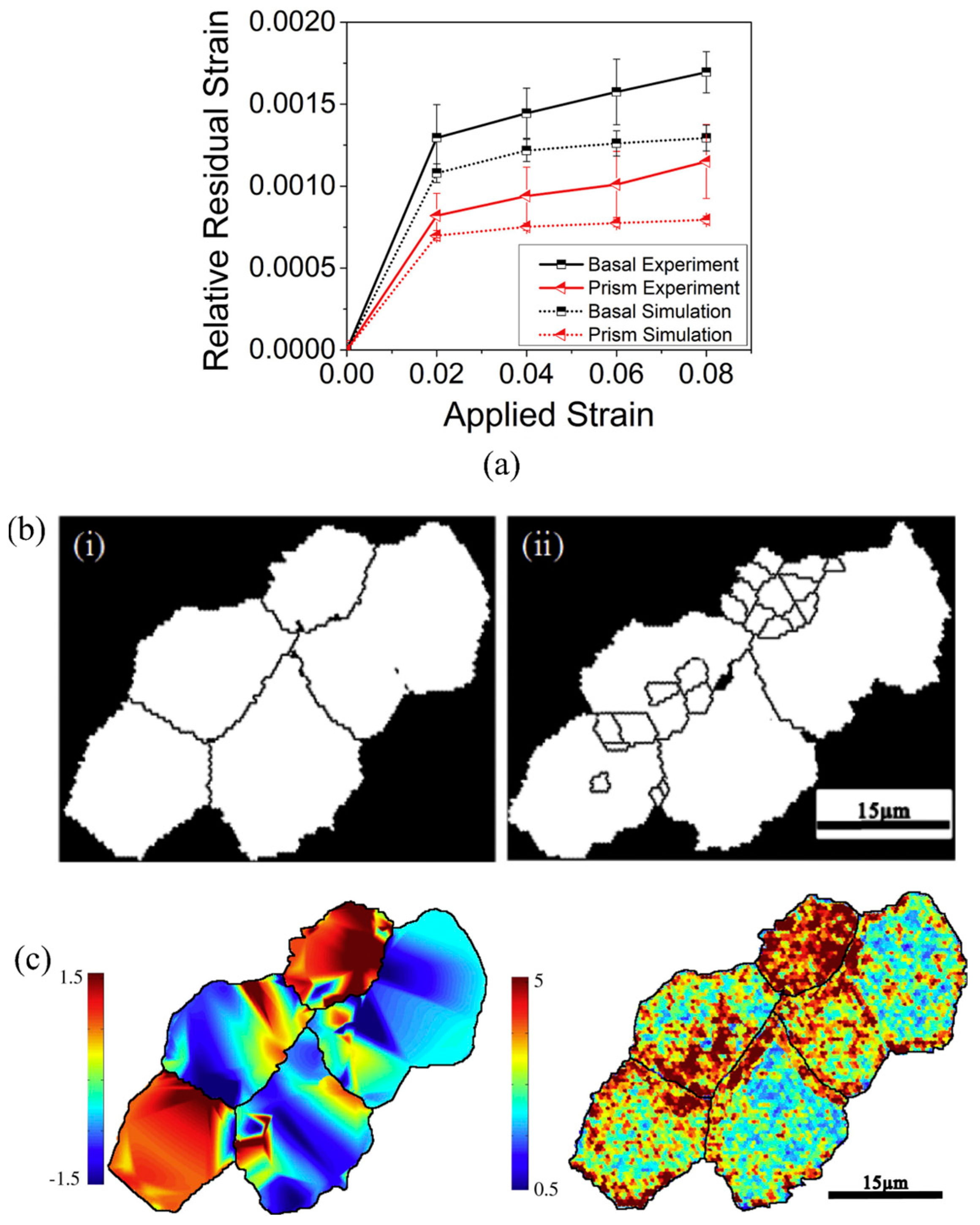
3. Deformed Microstructure and Texture in Titanium
3.1. Microstructure and Texture Evolution during Rolling
3.1.1. Mechanism of Split-TD Texture Formation
3.1.2. Influence of Strain Path
3.1.3. Mechanism of Texture Formation during Cross Rolling
3.1.4. Influence of Temperature
3.1.5. Influence of Shear
3.1.6. Influence of Grain Size
3.2. Microstructure and Texture Evolution during Extrusion and Drawing
3.3. Microstructure and Texture during Annealing
3.3.1. Microstructure and Texture Evolution during Primary Recrystallization
3.3.2. Microstructure and Texture Evolution during Secondary Recrystallization
4. Microstructure and Texture Evolution in Magnesium Alloys
4.1. Microstructure and Texture during Annealing
4.2. Texture Evolution in Plastically Deformed and Heat-Treated Materials
4.3. Influence Strain Rate on Plastic Deformation and Texture Development
4.4. Effect of Temperature on Plastic Deformation and Texture Development
5. Summary
- In Zr, the anisotropy in plastic deformation leads to significant heterogeneities in strain accommodation. For example, during RT and elevated temperature plastic deformation, Zr undergoes grain fragmentation for specific crystallographic orientations, and a significant difference in imposed shear strain is observed near the GBs. Due to the deformation anisotropy in Zr, which is both orientation and temperature-sensitive, strong crystallographic textures often lead to hierarchical differences in deformation texture evolution and residual stresses. The activation of different slip and twin systems is highly dependent on the starting crystallographic texture and working temperatures. Anomalous behavior of basal slip is also observed at higher working temperatures in some cases, which is currently attributed to the oxygen content in the samples. Stored energy and dislocation development in Zr strongly depend on the crystallographic texture and deformation configuration, i.e., strain path and grain morphology. On the other hand, annealing textures are highly dependent on starting crystallographic orientations.
- In CP-Ti, the most common rolling texture is a split-TD type texture, which forms because of primary compression twinning followed by secondary extension twinning. Activation of basal slip systems changes the final texture to basal fiber texture ( || ND) due to activation of basal slip systems. Variation in strain path causes lower deformation heterogeneities and variation in crystallographic texture due to a relatively higher number of active slip systems. The presence of high shear components leads to higher activity of basal and pyramidal slip systems and results in a strong basal fiber and a partial || RD texture. The recrystallization texture of Ti is largely dependent upon the deformation texture and the recrystallization temperature. The annealing texture that develops between 773 K and 973 K consists of and , ±30° to the TD. When the temperature range is above 973 K, substantial grain growth occurs, and the recrystallization texture consists of either or components manifest as ±30° across the TD line on the (0001) pole figure.
- In Mg alloys, minor variations in the strain path lead to variations in deformation magnitude and have been shown to cause asymmetry in texture evolution. Various types of twins evolve in Mg alloys during deformation, including tensile twins, compression twins, and secondary twins. Deformation mechanisms at lower temperatures lead to inhomogeneous deformation, increased SBs, and cracking. Higher temperatures generally enhance the ductility of Mg alloy due to increased thermal activation of dislocations and reduced resistance to slip. Yield strength and flow stress decrease with increasing temperature, attributed to the activation of different slip systems and twinning mechanisms. The strain rate also affects the twinning behavior, which is crucial for yield strength and deformation mechanisms in AZ31 Mg alloys. Higher strain rates in extruded-annealed AZ91 Mg alloy enhance strength but reduce elongation and promote rapid dislocation accumulation.
Author Contributions
Funding
Data Availability Statement
Conflicts of Interest
Abbreviations
References
- Bishoyi, B.D.; Sabat, R.K.; Sahu, J.; Sahoo, S.K. Effect of Temperature on Microstructure and Texture Evolution during Uniaxial Tension of Commercially Pure Titanium. Mater. Sci. Eng. A 2018, 703, 399–412. [Google Scholar] [CrossRef]
- Beer, A.G.; Barnett, M.R. Microstructural Development during Hot Working of Mg-3Al-1Zn. Metall. Mater. Trans. A 2007, 38, 1856–1867. [Google Scholar] [CrossRef]
- Guo, L.; Fujita, F. Effect of Deformation Mode, Dynamic Recrystallization and Twinning on Rolling Texture Evolution of AZ31 Magnesium Alloys. Trans. Nonferrous Met. Soc. China 2018, 28, 1094–1102. [Google Scholar] [CrossRef]
- Lutjering, G.; Williams, J.; Titanium. Engineering Materials and Processes, 2nd ed.; Springer: Berlin/Heidelberg, Germany, 2007. [Google Scholar]
- Banerjee, D.; Williams, J.C. Perspectives on Titanium Science and Technology. Acta Mater. 2013, 61, 844–879. [Google Scholar] [CrossRef]
- McCabe, R.J.; Cerreta, E.K.; Misra, A.; Kaschner, G.C.; Tomé, C.N. Effects of Texture, Temperature and Strain on the Deformation Modes of Zirconium. Philos. Mag. 2006, 86, 3595–3611. [Google Scholar] [CrossRef]
- Deng, S.; Song, H.; Zheng, C.; Zhao, T.; Zhang, S.; Nielsen, K.B. Selection of Deformation Modes and Related Texture Evolution in Zircaloy-4 during One Pass Cold Pilgering. Mater. Sci. Eng. A 2019, 764, 138280. [Google Scholar] [CrossRef]
- Azevedo, C.R.F. Selection of Fuel Cladding Material for Nuclear Fission Reactors. Eng. Fail. Anal. 2011, 18, 1943–1962. [Google Scholar] [CrossRef]
- Hanawa, T.; Nomura, N. Zirconium and Zirconium Alloys for Biomedical Use. In Advances in Materials Science Research: Volume 52; Nova Science Publishers, Inc.: New York, NY, USA, 2022; pp. 107–144. [Google Scholar]
- Singh, J.; Mahesh, S.; Kumar, G.; Pant, P.; Srivastava, D.; Dey, G.K.; Saibaba, N.; Samajdar, I. Texture Development and Plastic Deformation in a Pilgered Zircaloy-4 Tube. Metall. Mater. Trans. A 2015, 46, 1927–1947. [Google Scholar] [CrossRef]
- Abe, H.; Iwamoto, T.; Yamamoto, Y.; Nishida, S.; Komatsu, R. Dimensional Accuracy of Tubes in Cold Pilgering. J. Mater. Process. Technol. 2016, 231, 277–287. [Google Scholar] [CrossRef]
- Gurao, N.P.; Akhiani, H.; Szpunar, J.A. Pilgering of Zircaloy-4: Experiments and Simulations. J. Nucl. Mater. 2014, 453, 158–168. [Google Scholar] [CrossRef]
- Krishna, K.V.M.; Sahoo, S.K.; Samajdar, I.; Neogy, S.; Tewari, R.; Srivastava, D.; Dey, G.K.; Das, G.H.; Saibaba, N.; Banarjee, S. Microstructural and Textural Developments during Zircaloy-4 Fuel Tube Fabrication. J. Nucl. Mater. 2008, 383, 78–85. [Google Scholar] [CrossRef]
- Verlinden, B.; Cahn, R.W. Thermo-Mechanical Processing of Metallic Materials, 1st ed.; Pergamon Materials Series; Pergamon materials series; Elsevier Science: Amsterdam, The Netherlands, 2007; ISBN 978-0-08-044497-0. [Google Scholar]
- Saibaba, N. Fabrication of Seamless Calandria Tubes by Cold Pilgering Route Using 3-Pass and 2-Pass Schedules. J. Nucl. Mater. 2008, 383, 63–70. [Google Scholar] [CrossRef]
- Beyerlein, I.J.; Tomé, C.N. A Dislocation-Based Constitutive Law for Pure Zr Including Temperature Effects. Int. J. Plast. 2008, 24, 867–895. [Google Scholar] [CrossRef]
- Bharat Reddy, G.; Sarkar, A.; Kapoor, R.; Kanjarla, A.K. Effect of Temperature on the Selection of Deformation Modes in Zircaloy-4. Mater. Sci. Eng. A 2018, 734, 210–223. [Google Scholar] [CrossRef]
- Knezevic, M.; Zecevic, M.; Beyerlein, I.J.; Bingert, J.F.; McCabe, R.J. Strain Rate and Temperature Effects on the Selection of Primary and Secondary Slip and Twinning Systems in HCP Zr. Acta Mater. 2015, 88, 55–73. [Google Scholar] [CrossRef]
- Sahoo, S.K.; Hiwarkar, V.D.; Samajdar, I.; Dey, G.K.; Srivastav, D.; Tiwari, R.; Banerjee, S. Heterogeneous Deformation in Single-Phase Zircaloy 2. Scr. Mater. 2007, 56, 963–966. [Google Scholar] [CrossRef]
- Keskar, N.; Mukherjee, S.; Mani Krishna, K.V.; Srivastava, D.; Dey, G.K.; Pant, P.; Doherty, R.D.; Samajdar, I. Quantifying the Mesoscopic Shear Strains in Plane Strain Compressed Polycrystalline Zirconium. Acta Mater. 2014, 69, 265–274. [Google Scholar] [CrossRef]
- Sahoo, S.K.; Hiwarkar, V.D.; Mani Krishna, K.V.; Samajdar, I.; Pant, P.; Pujari, P.K.; Dey, G.K.; Srivastav, D.; Tiwari, R.; Banerjee, S. Grain Fragmentation and Twinning in Deformed Zircaloy 2: Response to Positron Lifetime Measurements. Mater. Sci. Eng. A 2010, 527, 1427–1435. [Google Scholar] [CrossRef]
- Hiwarkar, V.D.; Sahoo, S.K.; Samajdar, I.; Satpathy, A.; Krishna, K.V.M.; Dey, G.K.; Srivastav, D.; Tewari, R.; Banarjee, S. Defining Recrystallization in Pilgered Zircaloy-4: From Preferred Nucleation to Growth Inhibition. J. Nucl. Mater. 2011, 412, 287–293. [Google Scholar] [CrossRef]
- Kumar, G.; Singh, R.; Singh, J.; Srivastava, D.; Dey, G.K.; Samajdar, I. Defining the Stages of Annealing in a Moderately Deformed Commercial Zirconium Alloy. J. Nucl. Mater. 2015, 466, 243–252. [Google Scholar] [CrossRef]
- Adamson, R.B.; Coleman, C.E.; Griffiths, M. Irradiation Creep and Growth of Zirconium Alloys: A Critical Review. J. Nucl. Mater. 2019, 521, 167–244. [Google Scholar] [CrossRef]
- Rodriguez, P. Nuclear Reactor Materials: Irradiation Effects. In Encyclopedia of Materials: Science and Technology; Buschow, K.H.J., Cahn, R.W., Flemings, M.C., Ilschner, B., Kramer, E.J., Mahajan, S., Veyssière, P., Eds.; Elsevier: Oxford, UK, 2001; pp. 6349–6361. ISBN 978-0-08-043152-9. [Google Scholar]
- Kumar, G.; Kanjarla, A.K.; Lodh, A.; Singh, J.; Singh, R.; Srivastava, D.; Dey, G.K.; Saibaba, N.; Doherty, R.D.; Samajdar, I. Burst Ductility of Zirconium Clads: The Defining Role of Residual Stress. Metall. Mater. Trans. A 2016, 47, 3882–3896. [Google Scholar] [CrossRef]
- Nagase, F.; Fuketa, T. Investigation of Hydride Rim Effect on Failure of Zircaloy-4 Cladding with Tube Burst Test. J. Nucl. Sci. Technol. 2005, 42, 58–65. [Google Scholar] [CrossRef]
- Gupta, A.; Khatirkar, R.K.; Kumar, A.; Thool, K.S.; Bhibhanshu, N.; Suwas, S. Texture Development During Cold Rolling of a β-Ti Alloy: Experiments and Simulations. Metall. Mater. Trans. A 2021, 52, 1031–1043. [Google Scholar] [CrossRef]
- Gupta, A.; Khatirkar, R.K.; Kumar, A.; Parihar, M.S. Investigations on the Effect of Heating Temperature and Cooling Rate on Evolution of Microstructure in an α + β Titanium Alloy. J. Mater. Res. 2018, 33, 946–957. [Google Scholar] [CrossRef]
- Jawed, S.F.; Liu, Y.J.; Wang, J.C.; Rabadia, C.D.; Wang, L.Q.; Li, Y.H.; Zhang, X.H.; Zhang, L.C. Tailoring Deformation and Superelastic Behaviors of Beta-Type Ti-Nb-Mn-Sn Alloys. J. Mech. Behav. Biomed. Mater. 2020, 110, 103867. [Google Scholar] [CrossRef] [PubMed]
- Singh, A.K.; Kaushik, L.; Pawar, S.; Singh, J.; Das, H.; Mondal, M.; Hong, S.-T.; Choi, S.-H. Unraveling the Heterogeneous Evolution of the Microstructure and Texture in the Thermomechanically Affected Zone of Commercially Pure Titanium during Friction Stir Processing. Int. J. Mech. Sci. 2023, 239, 107894. [Google Scholar] [CrossRef]
- Gupta, A.; Khatirkar, R.K.; Kumar, A.; Thool, K.; Bibhanshu, N.; Suwas, S. Microstructure and Texture Development in Ti-15V-3Cr-3Sn-3Al Alloy – Possible Role of Strain Path. Mater. Charact. 2019, 156, 109884. [Google Scholar] [CrossRef]
- Wang, Y.N.; Huang, J.C. Texture Analysis in Hexagonal Materials. Mater. Chem. Phys. 2003, 81, 11–26. [Google Scholar] [CrossRef]
- Salem, A.A.; Kalidindi, S.R.; Doherty, R.D.; Semiatin, S.L. Strain Hardening Due to Deformation Twinning in α-Titanium: Mechanisms. Metall. Mater. Trans. A 2006, 37, 259–268. [Google Scholar] [CrossRef]
- Rabadia, C.D.; Jawed, S.F.; Wang, J.; Siddhpura, M.; Siddhpura, A. Revised Semiempirical Approach to Predict the Occurrence of Twinning in Titanium Alloys. ACS Omega 2021, 6, 34056–34064. [Google Scholar] [CrossRef] [PubMed]
- Yazar, K.U.; Shamitha, M.; Suwas, S. Texture-Dependent Dwell Fatigue Response of Titanium. Philos. Mag. 2021, 101, 1443–1470. [Google Scholar] [CrossRef]
- Yazar, K.U.; Mishra, S.; Kumar, L.; Bahl, S.; Kumar, T.K.; Suwas, S. Texture Induced Planar Anisotropy of Dwell Fatigue Response in Titanium: Insights from Experiments and Crystal Plasticity Simulations. Int. J. Plast. 2022, 152, 103140. [Google Scholar] [CrossRef]
- Shin, E.J.; Jung, A.; Choi, S.-H.; Rollett, A.D.; Park, S.S. A Theoretical Prediction of Twin Variants in Extruded AZ31 Mg Alloys Using the Microstructure Based Crystal Plasticity Finite Element Method. Mater. Sci. Eng. A 2012, 538, 190–201. [Google Scholar] [CrossRef]
- Song, J.; Chen, J.; Xiong, X.; Peng, X.; Chen, D.; Pan, F. Research Advances of Magnesium and Magnesium Alloys Worldwide in 2021. J. Magnes. Alloy 2022, 10, 863–898. [Google Scholar] [CrossRef]
- Choi, S.-H.; Shin, E.J.; Seong, B.S. Simulation of Deformation Twins and Deformation Texture in an AZ31 Mg Alloy under Uniaxial Compression. Acta Mater. 2007, 55, 4181–4192. [Google Scholar] [CrossRef]
- Pandey, A.; Kabirian, F.; Hwang, J.-H.; Choi, S.-H.; Khan, A.S. Mechanical Responses and Deformation Mechanisms of an AZ31 Mg Alloy Sheet under Dynamic and Simple Shear Deformations. Int. J. Plast. 2015, 68, 111–131. [Google Scholar] [CrossRef]
- Bhattacharyya, J.J.; Wang, F.; Stanford, N.; Agnew, S.R. Slip Mode Dependency of Dislocation Shearing and Looping of Precipitates in Mg Alloy WE43. Acta Mater. 2018, 146, 55–62. [Google Scholar] [CrossRef]
- Singh, J.; Mahesh, S.; Kumar, G. Deformation Twinning in Zirconium: Direct Experimental Observations and Polycrystal Plasticity Predictions. Metall. Mater. Trans. A 2015, 46, 5058–5071. [Google Scholar] [CrossRef]
- Ghosh, A.; Singh, A.; Gurao, N.P. Effect of Rolling Mode and Annealing Temperature on Microstructure and Texture of Commercially Pure-Titanium. Mater. Charact. 2017, 125, 83–93. [Google Scholar] [CrossRef]
- Gurao, N.P.; Sethuraman, S.; Suwas, S. Evolution of Texture and Microstructure in Commercially Pure Titanium with Change in Strain Path during Rolling. Metall. Mater. Trans. A Phys. Metall. Mater. Sci. 2013, 44, 1497–1507. [Google Scholar] [CrossRef]
- Bozzolo, N.; Dewobroto, N.; Wenk, H.R.; Wagner, F. Microstructure and Microtexture of Highly Cold-Rolled Commercially Pure Titanium. J. Mater. Sc. 2007, 42, 2405–2416. [Google Scholar] [CrossRef]
- Bahl, S.; Suwas, S.; Chatterjee, K. The Importance of Crystallographic Texture in the Use of Titanium as an Orthopedic Biomaterial. RSC Adv. 2014, 4, 38078–38087. [Google Scholar] [CrossRef]
- Chun, Y.B.; Yu, S.H.; Semiatin, S.L.; Hwang, S.K. Effect of Deformation Twinning on Microstructure and Texture Evolution during Cold Rolling of CP-Titanium. Mater. Sci. Eng. A 2005, 398, 209–219. [Google Scholar] [CrossRef]
- Shankar, S.; O’Brien, T.D. Texture Formation and Transition in Cold-Rolled Titanium. Mater. Sci. Eng. A 1988, 100, 109–114. [Google Scholar] [CrossRef]
- Zhong, Y.; Yin, F.; Nagai, K. Role of Deformation Twin on Texture Evolution in Cold-Rolled Commercial-Purity Ti. J. Mater. Res. 2008, 23, 2954–2966. [Google Scholar] [CrossRef]
- Gurao, N.P.; Suwas, S. Evolution of Crystallographic Texture during Deformation of Submicron Grain Size Titanium. J. Mater. Res. 2011, 26, 523–532. [Google Scholar] [CrossRef]
- Sahoo, S.K.; Sabat, R.K.; Sahni, S.; Suwas, S. Texture and Microstructure Evolution of Commercially Pure Titanium during Hot Rolling: Role of Strain-Paths. Mater. Des. 2016, 91, 58–71. [Google Scholar] [CrossRef]
- Yang, H.; Wang, Y. Effect of Shear Deformation on Texture Evolution in Rolled Pure Titanium. MATEC Web Conf. 2018, 186, 02002. [Google Scholar] [CrossRef]
- Milner, J.L.; Abu-farha, F.; Kurfess, T.; Hammond, V.H. Effects of Induced Shear Deformation on Microstructure and Texture Evolution in CP-Ti Rolled Sheets. Mater. Sci. Eng. A 2014, 619, 12–25. [Google Scholar] [CrossRef]
- Zherebtsov, S.; Lojkowski, W.; Mazur, A.; Salishchev, G. Structure and Properties of Hydrostatically Extruded Commercially Pure Titanium. Mater. Sci. Eng. A 2010, 527, 5596–5603. [Google Scholar] [CrossRef]
- Bishoyi, B.; Vinjamuri, R.; Sabat, R.K.; Patro, S.K.; Suwas, S.; Sahoo, S.K. Cold Drawing of Commercially Pure Titanium and Its Effect on Microstructure and Texture Evolution. Metall. Mat. Trans. A 2022, 53, 1845–1858. [Google Scholar] [CrossRef]
- Shankar, G.; Raguraman, S.; Barrales-mora, L.A.; Suwas, S. Development of Recrystallization Texture in Commercially Pure Titanium: Experiments and Simulation. JOM 2020, 72, 4559–4573. [Google Scholar] [CrossRef]
- Bozzolo, N.; Dewobroto, N.; Grosdidier, T.; Wagner, F. Texture Evolution during Grain Growth in Recrystallized Commercially Pure Titanium. Mater. Sci. Eng. A 2005, 397, 346–355. [Google Scholar] [CrossRef]
- Lee, J.U.; Kim, Y.J.; Kim, S.-H.; Lee, J.H.; Kim, M.-S.; Choi, S.-H.; Moon, B.G.; Kim, Y.M.; Park, S.H. Texture Tailoring and Bendability Improvement of Rolled AZ31 Alloy Using {10–12} Twinning: The Effect of Precompression Levels. J. Magnes. Alloy 2019, 7, 648–660. [Google Scholar] [CrossRef]
- Zhao, L.; Zhu, W.; Chen, W.; Zhao, X.; Yan, C.; Hong, R.; Jin, Z. An Insight into Mechanical Response and Twinning Behavior of Bimodal Textured AZ31 Magnesium Alloy under Quasi-Static and High Strain Rate Compression. J. Mater. Res. Tech. 2023, 27, 4692–4705. [Google Scholar] [CrossRef]
- Mo, Y.; Jiang, F.; Xu, H.; Tang, J.; Fu, D.; Zhang, H.; Teng, J. Deformation Mechanisms and Microstructural Characteristics of AZ61 Magnesium Alloys Processed by a Continuous Expansion Extrusion Approach. J. Magnes. Alloy, 2022; in press. [Google Scholar] [CrossRef]
- Qin, D.H.; Wang, M.J.; Sun, C.Y.; Su, Z.X.; Qian, L.Y.; Sun, Z.H. Interaction between Texture Evolution and Dynamic Recrystallization of Extruded AZ80 Magnesium Alloy during Hot Deformation. Mater. Sci. Eng. A 2020, 788, 139537. [Google Scholar] [CrossRef]
- Wang, D.; Jing, Y.; Lin, B.; Li, J.; Shi, Y.; Misra, R.D.K. On the Structure, Mechanical Behavior, and Deformation Mechanism of AZ91 Magnesium Alloy Processed by Symmetric and Asymmetric Rolling. Mater. Charact. 2022, 194, 112444. [Google Scholar] [CrossRef]
- Chai, F.; Ma, Z.; Han, X.; Hu, X.; Chang, Z.; Zhou, J. Effect of Strain Rates on Mechanical Behavior, Microstructure Evolution and Failure Mechanism of Extruded-Annealed AZ91 Magnesium Alloy under Room-Temperature Tension. J. Mat. Res. Tech. 2023, 27, 4644–4656. [Google Scholar] [CrossRef]
- Cui, C.; Zhang, W.; Chen, W.; He, J.; Chen, X.; Hou, J. Microstructure, Texture Evolution and Yield Strength Symmetry Improvement of as-Extruded ZK60 Mg Alloy via Multi-Directional Impact Forging. J. Magnes. Alloy 2022, 10, 2745–2760. [Google Scholar] [CrossRef]
- Verma, K.K.; Kumar, S.; Suwas, S. Evolution of Microstructure and Texture during Hot Rolling and Subsequent Annealing of the TZ73 Magnesium Alloy and Its Influence on Tensile Properties. Mater. Sci. Eng. A 2021, 821, 141480. [Google Scholar] [CrossRef]
- Liu, W.; Zhao, Y.; Zhang, Y.; Shuai, C.; Chen, L.; Huang, Z.; Hou, H. Deformation-Induced Dynamic Precipitation of 14H-LPSO Structure and Its Effect on Dynamic Recrystallization in Hot-Extruded Mg-Y-Zn Alloys. Int. J. Plast. 2023, 164, 103573. [Google Scholar] [CrossRef]
- Xin, T.; Tang, S.; Ji, F.; Cui, L.; He, B.; Lin, X.; Tian, X.; Hou, H.; Zhao, Y.; Ferry, M. Phase Transformations in an Ultralight BCC Mg Alloy during Anisothermal Ageing. Acta Mater. 2022, 239, 118248. [Google Scholar] [CrossRef]
- Zhang, Q.; Chen, Z.; Li, Q.; Chen, X.; Zhao, J.; Bao, J. Deformation Behavior Characterized by Reticular Shear Bands and Long Chain Twins in Mg-Gd-Nd(-Zn)-Zr Alloys. J. Mat. Res. Tech. 2021, 15, 5326–5342. [Google Scholar] [CrossRef]
- Murty, K.L.; Charit, I. Texture Development and Anisotropic Deformation of Zircaloys. Prog. Nucl. Ener. 2006, 48, 325–359. [Google Scholar] [CrossRef]
- MacEwen, S.R.; Christodoulou, N.; Salinas-Rodríguez, A. Residual Grain-Interaction Stresses in Zirconium Alloys. Metall. Trans. A 1990, 21, 1083–1095. [Google Scholar] [CrossRef]
- Tenckhoff, E. Deformation Mechanisms, Texture, and Anisotropy in Zirconium And Zircaloy; ASTM Special Technical Publication 966; American Society for Testing and Materials: Philadelphia, PA, USA, 1988; ISBN 978-0-8031-5039-3. [Google Scholar]
- Kalidindi, S.R. Modeling Anisotropic Strain Hardening and Deformation Textures in Low Stacking Fault Energy Fcc Metals. Int. J. Plast. 2001, 17, 837–860. [Google Scholar] [CrossRef]
- Cockeram, B.V.; Hollenbeck, J.L. The Role of Stress-State on the Deformation and Fracture Mechanism of Hydrided and Non-Hydrided Zircaloy-4. J. Nucl. Mater. 2015, 467, 9–31. [Google Scholar] [CrossRef]
- Withers, P.J.; Bhadeshia, H.K.D.H. Residual Stress. Part 2—Nature and Origins. Mater. Sc. Tech. 2001, 17, 366–375. [Google Scholar] [CrossRef]
- Kumar, G.; Lodh, A.; Singh, J.; Singh, R.; Srivastava, D.; Dey, G.; Samajdar, I. Experimental Characterization and Finite Element Modeling of through Thickness Deformation Gradient in a Cold Rolled Zirconium Sheet. CIRP J. Man. Sc. Tech. 2017, 19, 176–190. [Google Scholar] [CrossRef]
- Li, Y.; Po, G.; Cui, Y.; Ghoniem, N. Prismatic-to-Basal Plastic Slip Transition in Zirconium. Acta Mater. 2023, 242, 118451. [Google Scholar] [CrossRef]
- Gong, J.; Benjamin Britton, T.; Cuddihy, M.A.; Dunne, F.P.E.; Wilkinson, A.J. <a> Prismatic, <a> Basal, and <c+a> Slip Strengths of Commercially Pure Zr by Micro-Cantilever Tests. Acta Mater. 2015, 96, 249–257. [Google Scholar] [CrossRef]
- Wu, Z.; Curtin, W.A. Mechanism and Energetics of <c+a> Dislocation Cross-Slip in Hcp Metals. Proc. Natl. Acad. Sci. USA 2016, 113, 11137–11142. [Google Scholar] [CrossRef] [PubMed]
- Soo, P.; Higgins, G.T. The Deformation of Zirconium-Oxygen Single Crystals. Acta Mater. 1968, 16, 177–186. [Google Scholar] [CrossRef]
- Akhtar, A.; Teghtsoonian, A. Plastic Deformation of Zirconium Single Crystals. Acta Mater. 1971, 19, 655–663. [Google Scholar] [CrossRef]
- Akhtar, A. Schmid’s Law and Prismatic Slip of Zirconium. Scr. Mater. 1975, 9, 859–861. [Google Scholar] [CrossRef]
- Akhtar, A. Compression of Zirconium Single Crystals Parallel to the C-Axis. J. Nucl. Mater. 1973, 47, 79–86. [Google Scholar] [CrossRef]
- Xu, F.; Holt, R.A.; Daymond, M.R. Modeling Texture Evolution during Uni-Axial Deformation of Zircaloy-2. J. Nucl. Mater. 2009, 394, 9–19. [Google Scholar] [CrossRef]
- Tenckhoff, E. Review of Deformation Mechanisms, Texture, and Mechanical Anisotropy in Zirconium and Zirconium Base Alloys. J. ASTM Int. 2005, 2, 1–26. [Google Scholar] [CrossRef]
- Chai, L.; Luan, B.; Xiao, D.; Zhang, M.; Murty, K.L.; Liu, Q. Microstructural and Textural Evolution of Commercially Pure Zr Sheet Rolled at Room and Liquid Nitrogen Temperatures. Mater. Des. 2015, 85, 296–308. [Google Scholar] [CrossRef]
- McCabe, R.J.; Proust, G.; Cerreta, E.K.; Misra, A. Quantitative Analysis of Deformation Twinning in Zirconium. Int. J. Plast. 2009, 25, 454–472. [Google Scholar] [CrossRef]
- He, W.; Chapuis, A.; Chen, X.; Liu, Q. Effect of Loading Direction on the Deformation and Annealing Behavior of a Zirconium Alloy. Mater. Sci. Eng. A 2018, 734, 364–373. [Google Scholar] [CrossRef]
- Vaibhaw, K.; Rao, S.V.R.; Jha, S.K.; Saibaba, N.; Jayaraj, R.N. Texture and Hydride Orientation Relationship of Zircaloy-4 Fuel Clad Tube during Its Fabrication for Pressurized Heavy Water Reactors. J. Nucl. Mater. 2008, 383, 71–77. [Google Scholar] [CrossRef]
- Liu, H.; Song, H.-W.; Deng, S.-Y.; Chen, S.-F.; Zhang, S.-H. Study on Formability Improvement of Zr-4 Sheets Based on Texture Optimization. Metals 2024, 14, 725. [Google Scholar] [CrossRef]
- Thool, K.S.; Mani Krishna, K.V.; Srivastava, D.; Patra, A.; Doherty, R.D.; Samajdar, I. Confirmation of Dynamically Recrystallized Grains in Hexagonal Zirconium through Local Internal Friction Measurements. Metall. Mat. Trans. A 2019, 50, 5000–5014. [Google Scholar] [CrossRef]
- Erinosho, T.O.; Dunne, F.P.E. Strain Localization and Failure in Irradiated Zircaloy with Crystal Plasticity. Int. J. Plast. 2015, 71, 170–194. [Google Scholar] [CrossRef]
- Honniball, P.D.; Preuss, M.; Rugg, D.; Quinta da Fonseca, J. Grain Breakup During Elevated Temperature Deformation of an HCP Metal. Metall. Mat. Trans. A 2015, 46, 2143–2156. [Google Scholar] [CrossRef]
- Guo, W.; Li, G.; Yuan, F.; Han, F.; Zhang, Y.; Ali, M.; Ren, J.; Yuan, G. Texture Development and Mechanical Behavior of Zircaloy-4 Alloy Plates Fabricated by Cold Rolling and Annealing. Mater. Sci. Eng. A 2021, 807, 140846. [Google Scholar] [CrossRef]
- Thool, K.; Patra, A.; Fullwood, D.; Krishna, K.V.M.; Srivastava, D.; Samajdar, I. The Role of Crystallographic Orientations on Heterogeneous Deformation in a Zirconium Alloy: A Combined Experimental and Modeling Study. Int. J. Plast. 2020, 102785. [Google Scholar] [CrossRef]
- Kumar, G.; Balo, S.; Dhoble, A.; Singh, J.; Singh, R.; Srivastava, D.; Dey, G.K.; Samajdar, I. Through-Thickness Deformation Gradient in a Part-Pilgered Zirconium Tube: Experimental Measurements and Numerical Validation. Metall. Mat. Trans. A 2017, 48, 2844–2857. [Google Scholar] [CrossRef]
- Luan, B.; Gao, S.; Chai, L.; Li, X.; Chapuis, A.; Liu, Q. Compression Deformation Behavior of Zr-1Sn-0.3Nb Alloy with Different Initial Orientations at 650 °C. Mat. Des. 2013, 52, 1065–1070. [Google Scholar] [CrossRef]
- Chauvy, C.; Barbéris, P.; Montheillet, F. Dynamic Recrystallization of Zircaloy-4 during Working within the Upper α-Range. Mat. Sc. For. 2004, 467–470, 1151–1156. [Google Scholar] [CrossRef]
- Pérez-Prado, M.T.; Barrabes, S.R.; Kassner, M.E.; Evangelista, E. Dynamic Restoration Mechanisms in α-Zirconium at Elevated Temperatures. Acta Mater. 2005, 53, 581–591. [Google Scholar] [CrossRef]
- Chakravartty, J.K.; Kapoor, R.; Sarkar, A.; Banerjee, S.; Barberis, P.; Dean, S.W. Dynamic Recrystallization in Zirconium Alloys. J. ASTM Int. 2010, 7, 1–14. [Google Scholar] [CrossRef]
- Gerspach, F.; Bozzolo, N.; Wagner, F. About Texture Stability during Primary Recrystallization of Cold-Rolled Low Alloyed Zirconium. Scr. Mat. 2009, 60, 203–206. [Google Scholar] [CrossRef]
- Rawles, J.; Fialkova, S.; Hubbard, K.; Xu, Z.; Hale, C.; Sankar, J. Optimizing the Rolling Process of Lightweight Materials. Crystals 2024, 14, 582. [Google Scholar] [CrossRef]
- Wagner, F.; Bozzolo, N.; Van Landuyt, O.; Grosdidier, T. Evolution of Recrystallisation Texture and Microstructure in Low Alloyed Titanium Sheets. Acta Mater. 2002, 50, 1245–1259. [Google Scholar] [CrossRef]
- Ghosh, A. Anisotropic Tensile and Ratcheting Behavior of Commercially Pure Titanium Processed via Cross Rolling and Annealing. Int. J. Fatigue 2019, 120, 12–22. [Google Scholar] [CrossRef]
- Chen, C.; Han, D.; Song, Y.; Wang, M.; Li, Y.; Xu, S. Thermal Stability of Deformation Twins in Cryogenic Rolled CP-Ti. Mater. Charact. 2023, 196, 112587. [Google Scholar] [CrossRef]
- Williams, J.C.; Baggerly, R.G.; Paton, N.E. Deformation Behavior of HCP Ti-Al Alloy Single Crystals. Metall. Mat. Trans. A Phys. Metall. Mater. Sci. 2002, 33, 837–850. [Google Scholar] [CrossRef]
- Yazar, K.U.; Mishra, S.; Karmakar, A.; Bhattacharjee, A.; Suwas, S. On the Temperature Sensitivity of Dwell Fatigue of a Near Alpha Titanium Alloy: Role of Strain Hardening and Strain Rate Sensitivity. Metall. Mat. Trans. A 2020, 51, 5036–5042. [Google Scholar] [CrossRef]
- Gurao, N.P.; Kapoor, R.; Suwas, S. Deformation Behaviour of Commercially Pure Titanium at Extreme Strain Rates. Acta Mater. 2011, 59, 3431–3446. [Google Scholar] [CrossRef]
- Fundenberger, J.; Gottstein, G. Texture Evolution in Commercially Pure Titanium after Warm Equal Channel Angular Extrusion. Acta Mater. 2011, 59, 1121–1133. [Google Scholar] [CrossRef]
- Meyers, M.A.; Vöhringer, O.; Lubarda, V.A. The Onset of Twinning in Metals: A Constitutive Description. Acta Mater. 2001, 49, 4025–4039. [Google Scholar] [CrossRef]
- Rabadia, C.D.; Liu, Y.J.; Zhao, C.H.; Wang, J.C.; Jawed, S.F.; Wang, L.Q.; Chen, L.Y.; Sun, H.; Zhang, L.C. Improved Trade-off between Strength and Plasticity in Titanium Based Metastable Beta Type Ti-Zr-Fe-Sn Alloys. Mater. Sci. Eng. A 2019, 766, 138340. [Google Scholar] [CrossRef]
- Panchal, M.; Kaushik, L.; Kottan Renganayagalu, R.; Choi, S.-H.; Singh, J. Microstructure and Texture Evolution in AZX311 Mg Alloy during In-Plane Shear Deformation. J. Alloys Compd. 2024, 999, 174977. [Google Scholar] [CrossRef]
- Su, C.J.; Xu, T.T.; Zhang, K.; Zhang, K.; Lou, S.M.; Wang, Q. Plastic Deformation of Magnesium Alloy with Different Forming Parameters during Ultrasonic Vibration-Assisted Single-Point Incremental Forming. Rare Met. 2022, 41, 3878–3886. [Google Scholar] [CrossRef]
- Chen, W.; He, W.; Jiang, B.; Pan, F. Simultaneous Enhancement of Strength and Ductility for AZ31 Magnesium Alloy by Pre-Twinning Induced Heterostructure. Int. J. Plast. 2022, 159, 103483. [Google Scholar] [CrossRef]
- Li, L.; Suh, B.-C.; Suh, J.-S.; Kim, C.; Go, Y.; Kim, Y.M. Static Recrystallization Behavior of the Cold-Rolled Mg-1Al-1Zn-0.1Ca-0.2Y Magnesium Alloy Sheet. J. Alloys Compd. 2023, 938, 168508. [Google Scholar] [CrossRef]
- Li, N.; Yang, L.; Wang, C.; Monclús, M.A.; Shi, D.; Molina-Aldareguía, J.M. Deformation Mechanisms of Basal Slip, Twinning and Non-Basal Slips in Mg–Y Alloy by Micropillar Compression. Mater. Sci. Eng. A 2021, 819, 141408. [Google Scholar] [CrossRef]
- Shi, B.Q.; Wang, Y.Z.; Shang, X.L.; Zhao, L.Y.; Li, C.Q.; Chen, D.C.; Nie, B.H.; Chen, R.S.; Ke, W. Microstructure Evolution of Twinning-Induced Shear Bands and Correlation with ‘RD-Split’Texture during Hot Rolling in a Mg-1.1 Zn-0.76 Y-0.56 Zr Alloy. Mater. Charact. 2022, 187, 111853. [Google Scholar] [CrossRef]
- Mu, S.; Jonas, J.J.; Gottstein, G. Variant Selection of Primary, Secondary and Tertiary Twins in a Deformed Mg Alloy. Acta Mater. 2012, 60, 2043–2053. [Google Scholar] [CrossRef]
- Hong, S.-G.; Park, S.H.; Lee, C.S. Role of {10–12} Twinning Characteristics in the Deformation Behavior of a Polycrystalline Magnesium Alloy. Acta Mater. 2010, 58, 5873–5885. [Google Scholar] [CrossRef]
- Chino, Y.; Kimura, K.; Mabuchi, M. Twinning Behavior and Deformation Mechanisms of Extruded AZ31 Mg Alloy. Mater. Sci. Eng. A 2008, 486, 481–488. [Google Scholar] [CrossRef]
- Liu, Y.; Cai, S.; Dai, L. A New Method for Grain Refinement in Magnesium Alloy: High Speed Extrusion Machining. Mater. Sci. Eng. A 2016, 651, 878–885. [Google Scholar] [CrossRef]
- Wang, T.; Yang, L.; Tang, Z.; Wu, L.; Yan, H.; Liu, C.; Ma, Y.; Liu, W.; Yu, Z. Microstructure, Mechanical Properties and Deformation Mechanism of Powder Metallurgy AZ31 Magnesium Alloy during Rolling. Mater. Sci. Eng. A 2022, 844, 143042. [Google Scholar] [CrossRef]
- Peng, J.; Zhang, Z.; Guo, P.; Zhou, W.; Wu, Y. The Effect of Grain Size on Texture Evolution and Mechanical Properties of an AZ31 Magnesium Alloy during Cold-Rolling Process. J. Alloys Compd. 2020, 817, 153302. [Google Scholar] [CrossRef]
- Daghigh, M.; Mohri, M.; Ghanbari, H.; Nili-ahmadabadi, M. Enhanced Deformability of WE43 Magnesium Alloy by Activation of Non-Basal Slip and Twinning Deformation Modes in the Equal Channel Angular Pressing at Room Temperature. Mater. Let. 2023, 351, 135047. [Google Scholar] [CrossRef]
- Kandalam, S.; Sabat, R.K.; Bibhanshu, N.; Avadhani, G.S.; Kumar, S.; Suwas, S. Superplasticity in High Temperature Magnesium Alloy WE43. Mater. Sci. Eng. A 2017, 687, 85–92. [Google Scholar] [CrossRef]
- Dharmendra, C.; Rao, K.P.; Prasad, Y.; Hort, N.; Kainer, K.U. Hot Working Mechanisms and Texture Development in Mg-3Sn-2Ca-0.4 Al Alloy. Mat. Chem. Phy. 2012, 136, 1081–1091. [Google Scholar] [CrossRef]
- Panchal, M.; Kaushik, L.; Kim, M.-S.; Kottan Renganayagalu, R.; Choi, S.-H.; Singh, J. Effect of Pre-Twinning and Heat Treatment on Formability of AZX311 Mg Alloy. J. Magnes. Alloy 2024, 12, 1154–1169. [Google Scholar] [CrossRef]
- Koundinya, N.; Raman, L.; Chawake, N.; Kottada, R.S. Hot Deformation Behaviour of Mg-3Al-3Sn and Mg-3Al-3Sn-1 Zn Alloys: Role of Zn. Materialia 2018, 3, 274–287. [Google Scholar] [CrossRef]
- Jiang, M.G.; Yan, H.; Chen, R.S. Twinning, Recrystallization and Texture Development during Multi-Directional Impact Forging in an AZ61 Mg Alloy. J. Alloys Compd. 2015, 650, 399–409. [Google Scholar] [CrossRef]
- Lentz, M.; Risse, M.; Schaefer, N.; Reimers, W.; Beyerlein, I.J. Strength and Ductility with {1011}—{1012} Double Twinning in a Magnesium Alloy. Nat. Commun. 2016, 7, 11068. [Google Scholar] [CrossRef] [PubMed]
- Shi, X.Y.; Liu, Y.; Li, D.J.; Chen, B.; Zeng, X.Q.; Lu, J.; Ding, W.J. Microstructure Evolution and Mechanical Properties of an Mg–Gd Alloy Subjected to Surface Mechanical Attrition Treatment. Mater. Sci. Eng. A 2015, 630, 146–154. [Google Scholar] [CrossRef]
- Zhu, S.Q.; Ringer, S.P. On the Role of Twinning and Stacking Faults on the Crystal Plasticity and Grain Refinement in Magnesium Alloys. Acta Mater. 2018, 144, 365–375. [Google Scholar] [CrossRef]
- Tang, J.; Fan, H.; Wei, D.; Jiang, W.; Wang, Q.; Tian, X.; Zhang, X. Interaction between a {101‾ 2} Twin Boundary and Grain Boundaries in Magnesium. Int. J. Plast. 2020, 126, 102613. [Google Scholar] [CrossRef]
- Rajput, S.K.; Chaudhari, G.P.; Nath, S.K. Characterization of Hot Deformation Behavior of a Low Carbon Steel Using Processing Maps, Constitutive Equations and Zener-Hollomon Parameter. J. Mater. Proc. Tech. 2016, 237, 113–125. [Google Scholar] [CrossRef]
- Sandlöbes, S.; Friák, M.; Zaefferer, S.; Dick, A.; Yi, S.; Letzig, D.; Pei, Z.; Zhu, L.-F.; Neugebauer, J.; Raabe, D. The Relation between Ductility and Stacking Fault Energies in Mg and Mg–Y Alloys. Acta Mater. 2012, 60, 3011–3021. [Google Scholar] [CrossRef]
- Xu, J.; Guan, B.; Zhao, X.; Fu, R.; Hu, Q.; Liu, C. Strain Rate Dependence of Twinning Behavior in AZ31 Mg Alloys. Metals 2023, 13, 1882. [Google Scholar] [CrossRef]
- Wang, H.; Wu, P.; Kurukuri, S.; Worswick, M.J.; Peng, Y.; Tang, D.; Li, D. Strain Rate Sensitivities of Deformation Mechanisms in Magnesium Alloys. Int. J. Plast. 2018, 107, 207–222. [Google Scholar] [CrossRef]
- Ardeljan, M.; Beyerlein, I.J.; McWilliams, B.A.; Knezevic, M. Strain Rate and Temperature Sensitive Multi-Level Crystal Plasticity Model for Large Plastic Deformation Behavior: Application to AZ31 Magnesium Alloy. Int. J. Plast. 2016, 83, 90–109. [Google Scholar] [CrossRef]
- Singh, J.; Kim, M.-S.; Kaushik, L.; Kang, J.-H.; Kim, D.; Martin, E.; Choi, S.-H. Twinning-Detwinning Behavior of E-Form Mg Alloy Sheets during in-Plane Reverse Loading. Int. J. Plast. 2020, 127, 102637. [Google Scholar] [CrossRef]
- Gehrmann, R.; Frommert, M.M.; Gottstein, G. Texture Effects on Plastic Deformation of Magnesium. Mater. Sci. Eng. A 2005, 395, 338–349. [Google Scholar] [CrossRef]
- Wang, Y.-Y.; Jia, C.; Xu, M.; Kaseem, M.; Tayebi, M. Microstructural Changes Caused by the Creep Test in ZK60 Alloy Reinforced by SiCp at Intermediate Temperature after KOBO Extrusion and Aging. Materials 2023, 16, 3885. [Google Scholar] [CrossRef]
- Wang, Z.; Cao, G.; Wang, F.; Zhou, L.; Mao, P.; Jiang, X.; Liu, Z. Investigation of the Microstructure and Properties of Extrusion-Shear Deformed ZC61 Magnesium Alloy under High Strain Rate Deformation. Mater. Charact. 2021, 172, 110839. [Google Scholar] [CrossRef]
- Wang, L.; Li, Y.; Zhang, H.; Zhang, Z.; Yang, Q.; Zhang, Q.; Wang, H.; Cheng, W.; Shin, K.S.; Vedani, M. Review: Achieving Enhanced Plasticity of Magnesium Alloys below Recrystallization Temperature through Various Texture Control Methods. J. Mat. Res. Tech. 2020, 9, 12604–12625. [Google Scholar] [CrossRef]
- Wang, Y.-Y.; Jia, C.; Tayebi, M.; Hamawandi, B. Microstructural Evolution during Accelerated Tensile Creep Test of ZK60/SiCp Composite after KoBo Extrusion. Materials 2022, 15, 6428. [Google Scholar] [CrossRef]
- Miao, X.; Li, Z.; Liu, S.; Hou, K.; Wang, J.; Yang, S. Ionic Bridging Strengthened MXene/GO Nanocomposite Films with Extraordinary Mechanical and Tribological Properties. Appl. Surf. Sc. 2023, 625, 157181. [Google Scholar] [CrossRef]
- Li, X.; Guo, F.; Ma, Y.; Jiang, L.; Lai, H.; Liu, H.; Zhang, D.; Pei, R. Rolling Texture Development in a Dual-Phase Mg-Li Alloy: The Role of Temperature. J. Magnes. Alloy 2023, 11, 2980–2990. [Google Scholar] [CrossRef]
- Watanabe, H.; Ishikawa, K. Effect of Texture on High Temperature Deformation Behavior at High Strain Rates in a Mg-3Al-1Zn Alloy. Mater. Sci. Eng. A 2009, 523, 304–311. [Google Scholar] [CrossRef]
- Khan, A.S.; Pandey, A.; Gnäupel-Herold, T.; Mishra, R.K. Mechanical Response and Texture Evolution of AZ31 Alloy at Large Strains for Different Strain Rates and Temperatures. Int. J. Plast. 2011, 27, 688–706. [Google Scholar] [CrossRef]


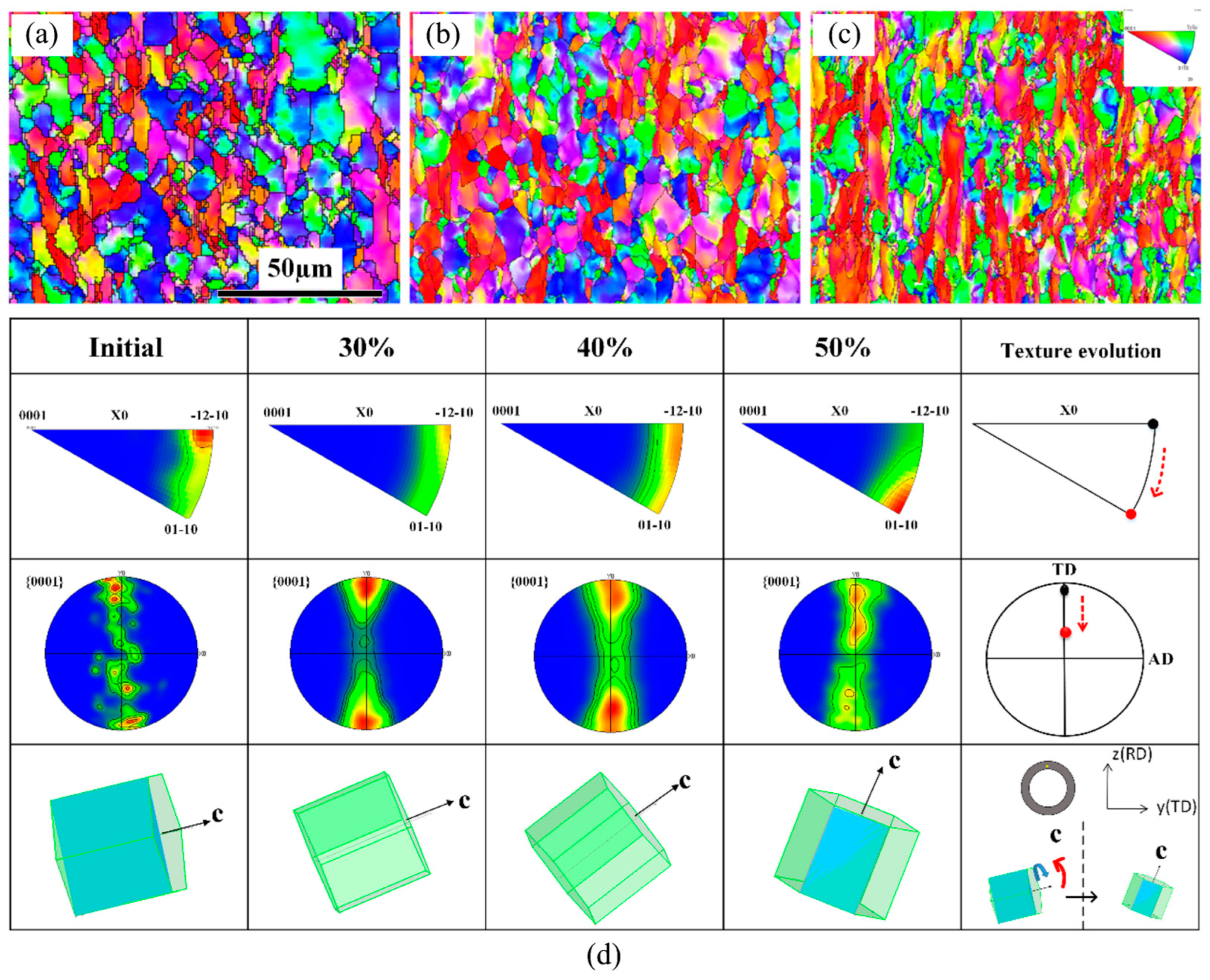
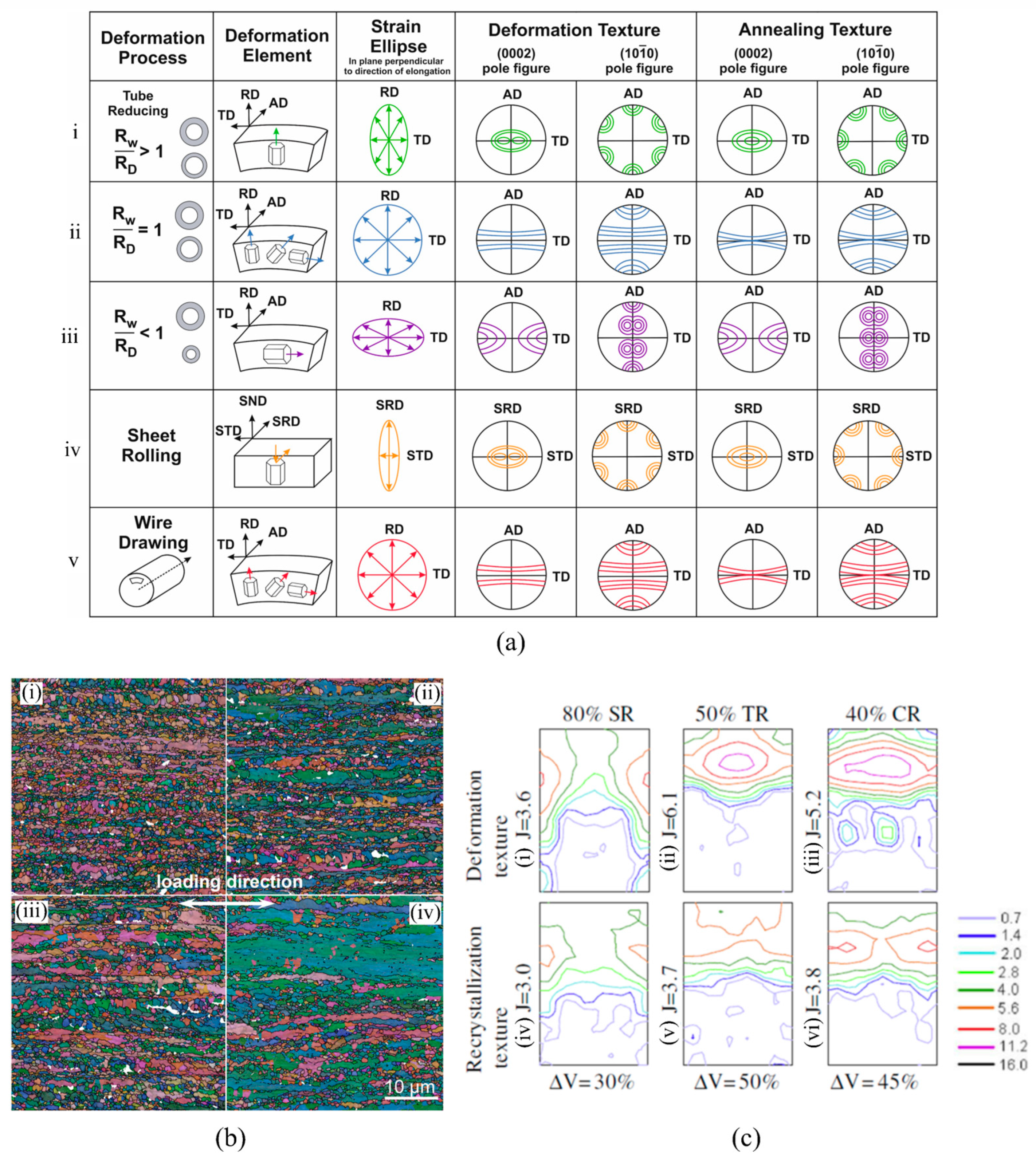
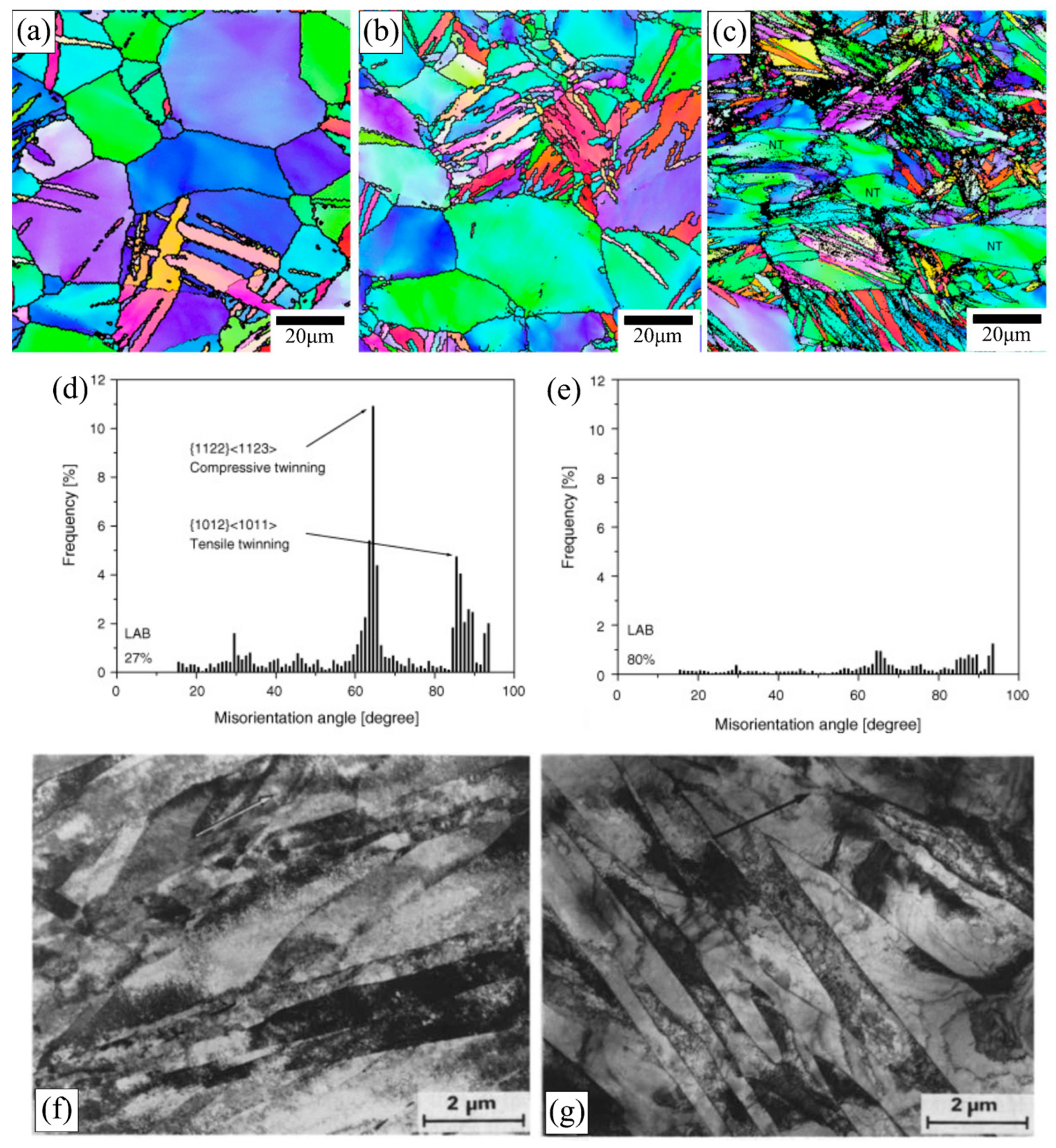

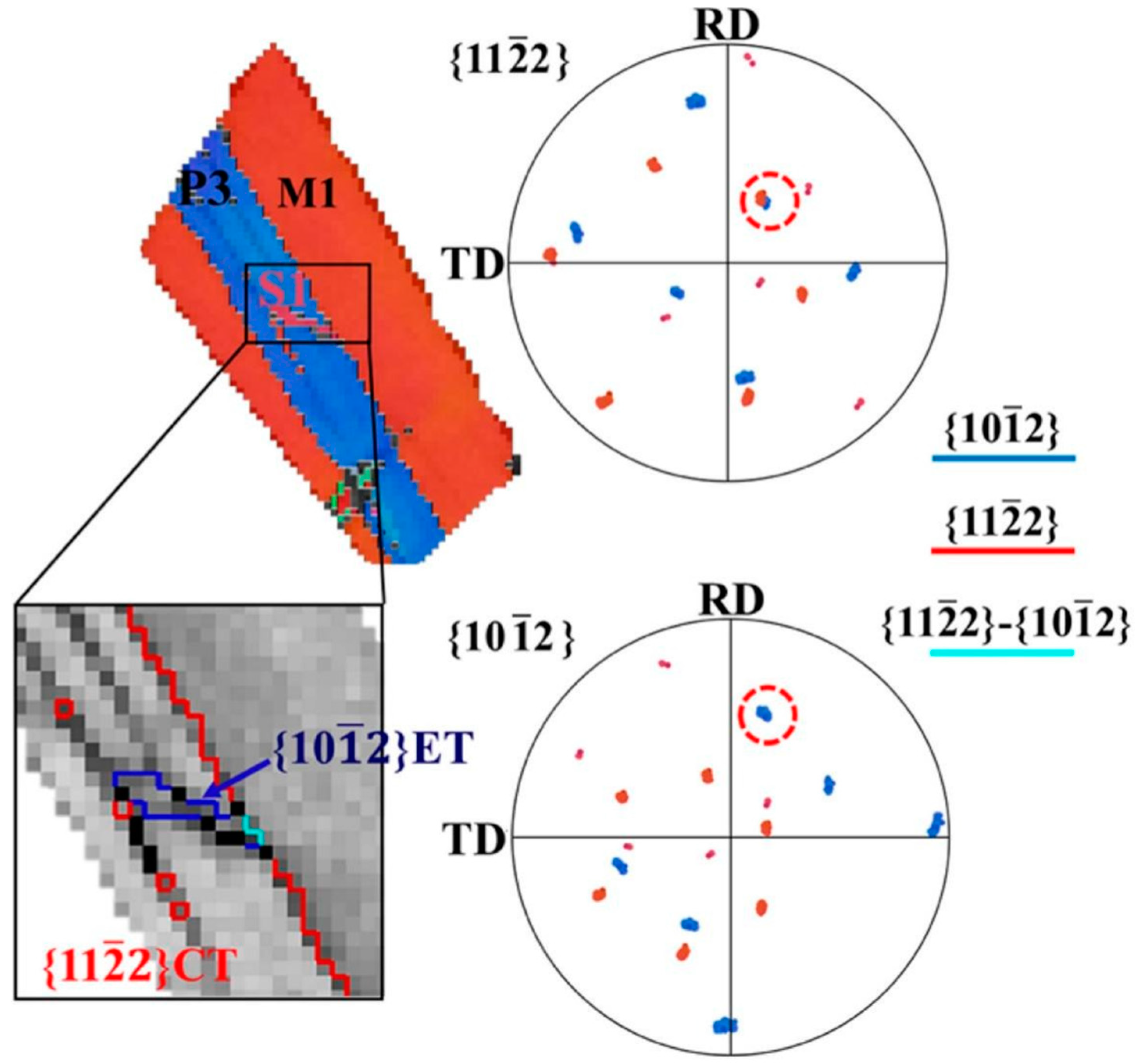
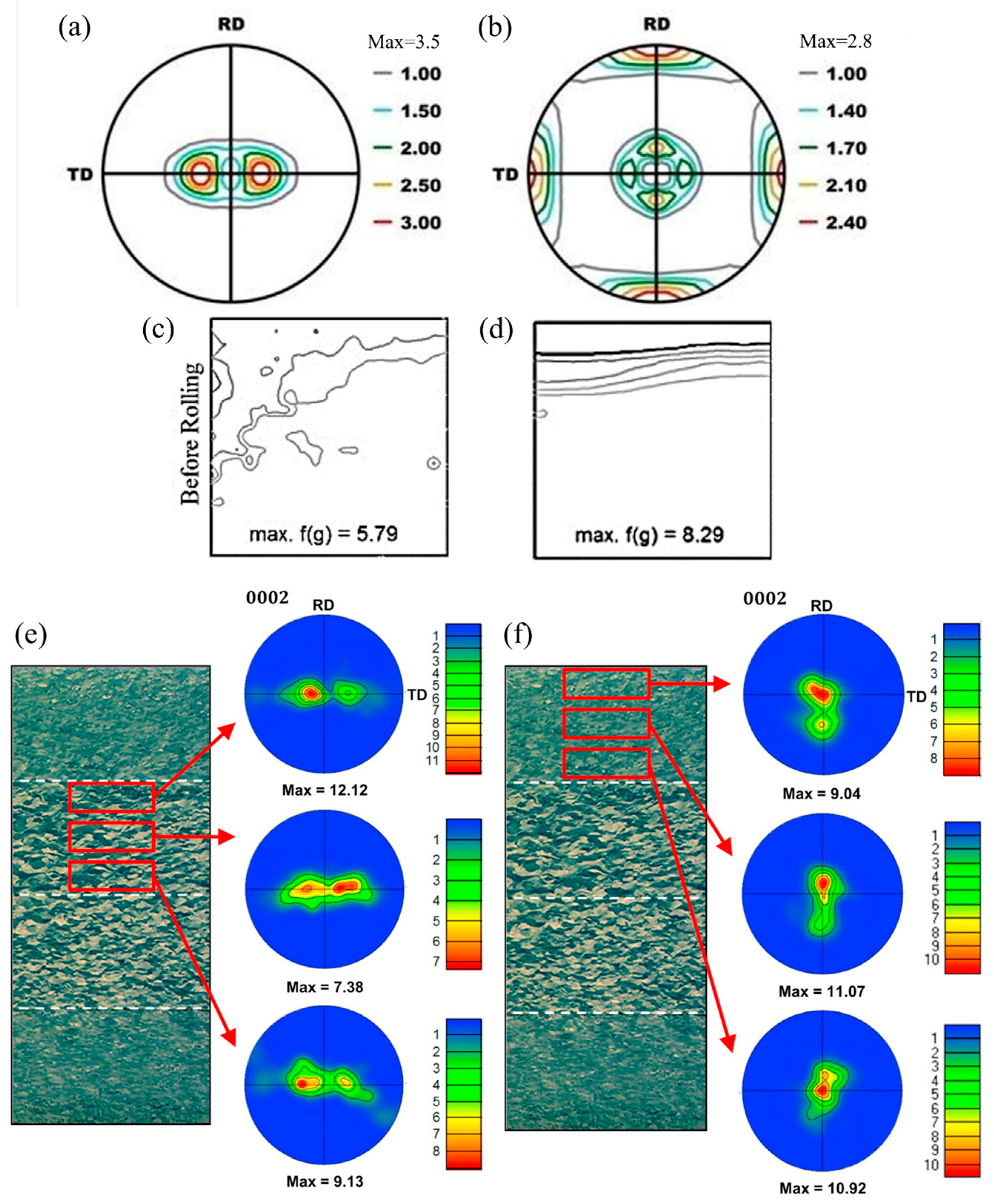



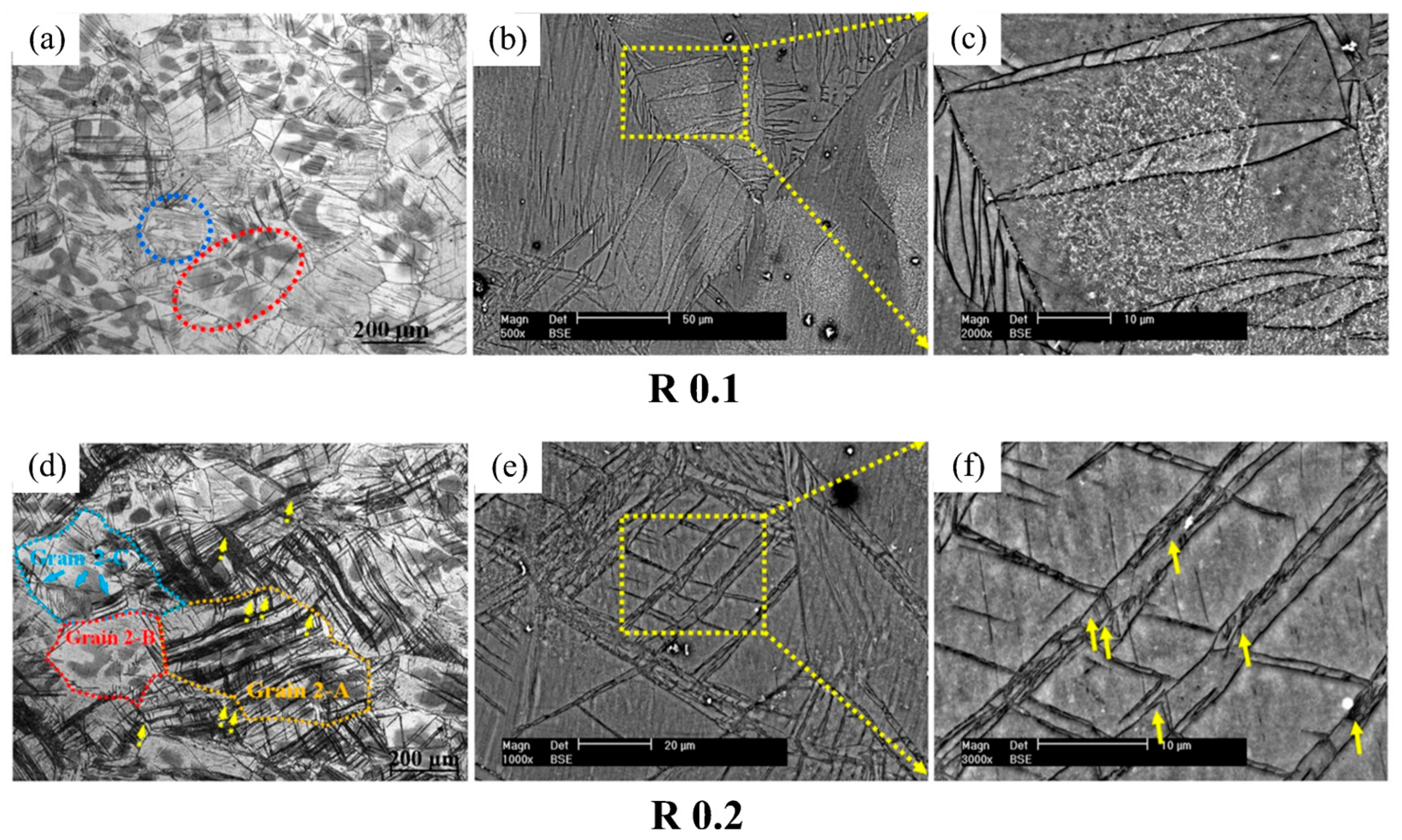

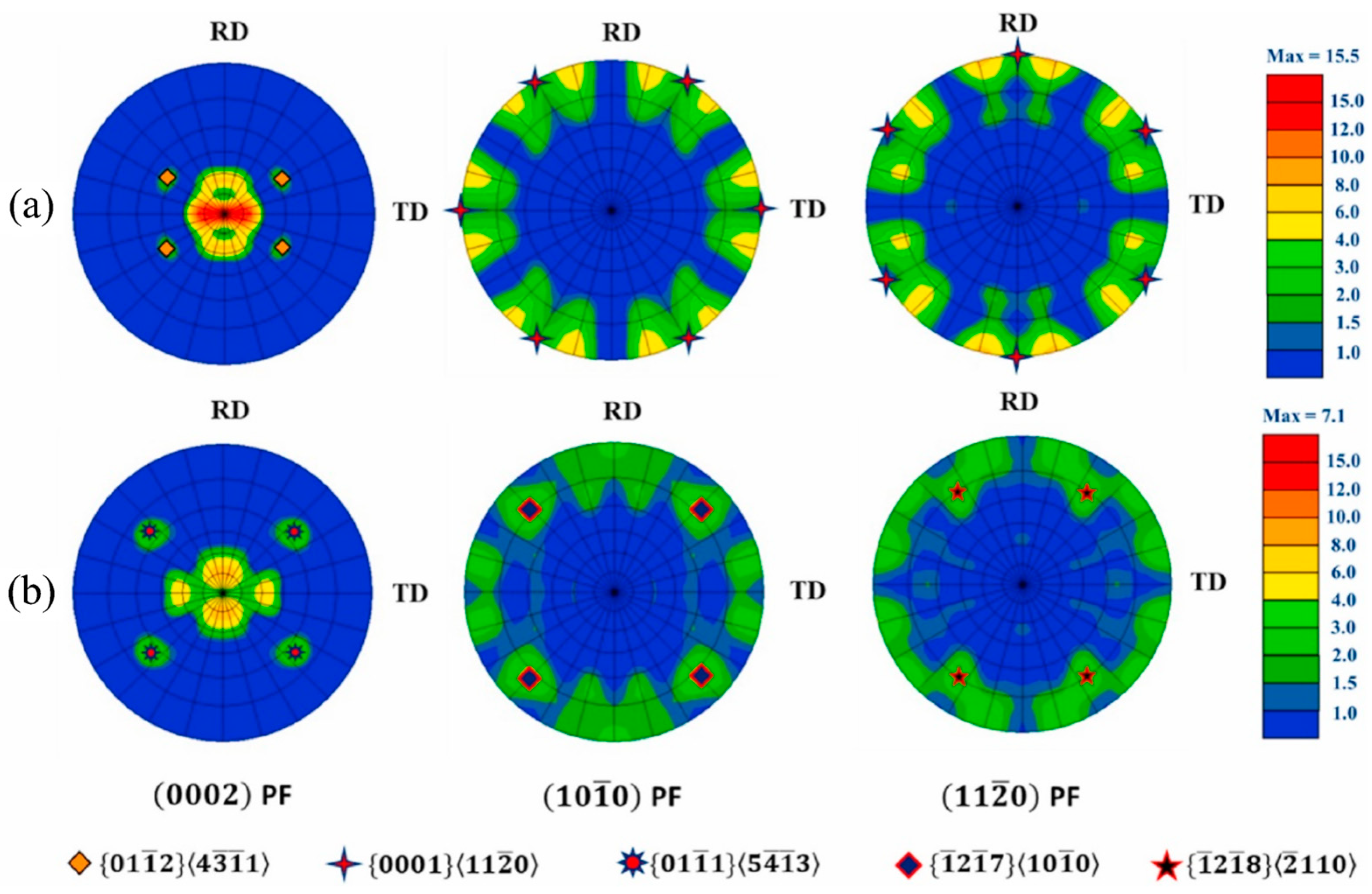

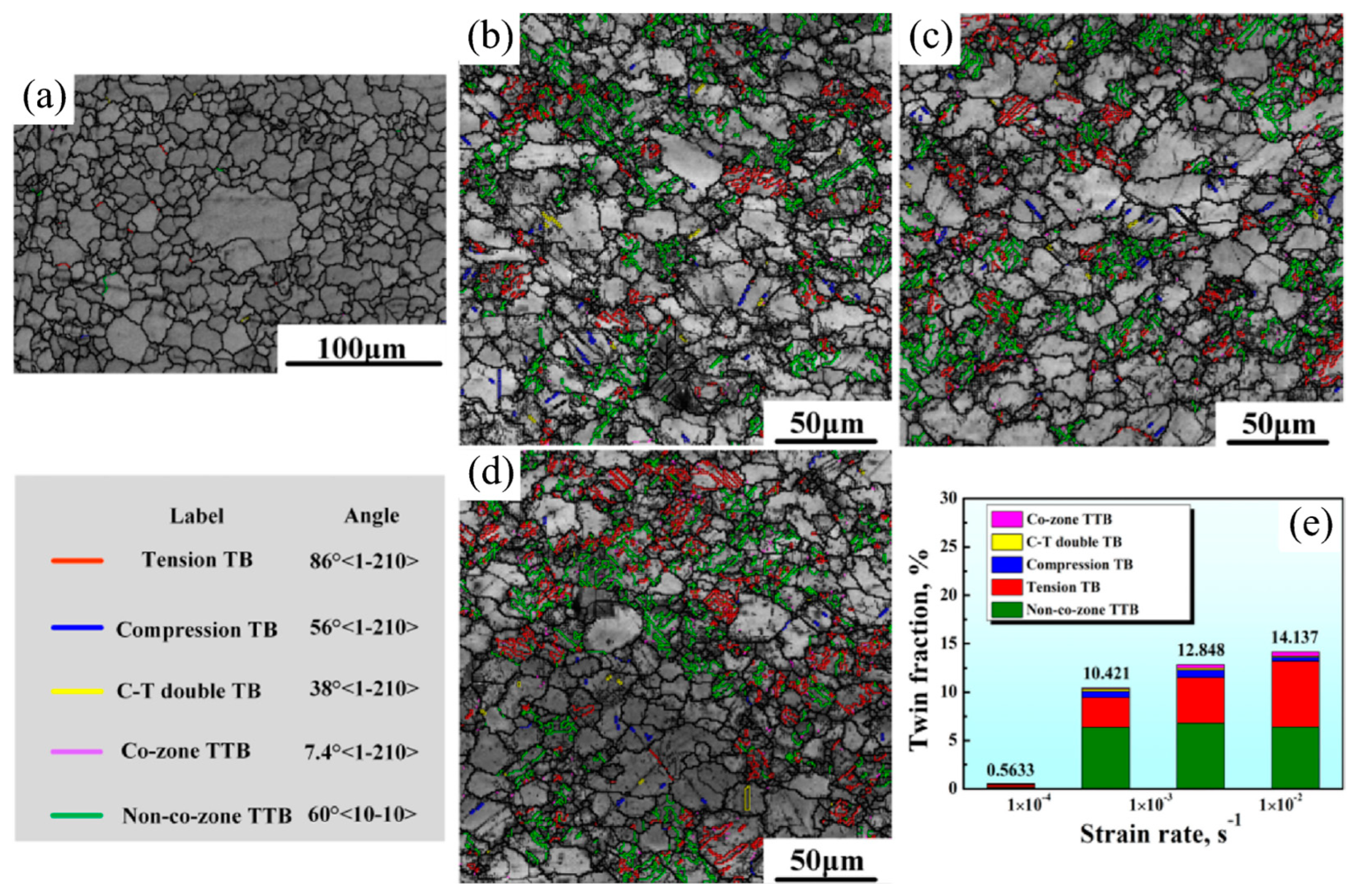

| S.No. | Grades/Alloys | Characteristics Discussed | Published Year/References |
|---|---|---|---|
| 1 | Zr-4 Fuel Tube | Pilgering, Texture anisotropy, slip activation | 2014 [12], 2015 [10] |
| 2 | Zr-4 sheet | Plane strain compression, Twinning, Role of initial texture | 2014 [20], 2015 [43] |
| 3 | Zr-4 Fuel Tube | Microstructure and texture developments | 2008 [13] |
| 4 | Zr-1.3Sn-0.2Fe-0.1Cr | Hot extrusion, pilgering | 2008 [15] |
| 5 | Clock-rolled pure Zr plate | Role of substructure, Selection of deformation modes, Coupling between slip modes, Coupling between slip and twinning modes | 2008 [16] |
| 6 | Clock-rolled high-purity Zr | Effects of initial texture, Effects of temperature and strain, Secondary twinning within primary twins | 2006 [6] |
| 7 | Rolled Zircaloy-4 plate | Twin boundary fraction and work-hardening rate, Effect of active deformation modes on the work-hardening rate, Double twinning | 2018 [17] |
| 8 | CP-Ti | Unidirectional cold rolling and split-TD texture | 2017 [44], 2013 [45], 2007 [46], 2014 [47], 2005 [48], 1987 [49], 2008 [50] |
| 9 | CP-Ti | Cold cross-rolling and split-RD texture due to varying strain path | 2017 [44], 2011 [51] |
| 10 | CP-Ti | Elevated temperature and formation of basal—fiber texture | 2014 [47], 2016 [52] |
| 11 | CP-Ti | Shear strain and formation of Basal fiber texture | 2018 [53], 2014 [54] |
| 12 | CP-Ti | Split-TD texture in submicron-grained material | 2011 [51] |
| 13 | CP-Ti | Fiber texture symmetric about extrusion and drawing axis | 2010 [55], 2022 [56] |
| 14 | CP-Ti | Primary recrystallization texture and microstructure | 2008 [50], 2020 [57] |
| 15 | CP-Ti | Secondary recrystallization texture and microstructure | 2017 [44], 2005 [58], 2020 [57] |
| 16 | AZ31 | Rolling Microstructure and Texture, Strain hardening behavior, plane slip, and twinning | 2019 [59], 2023 [60] |
| 17 | AZ61 | Deformation mechanism, slip systems | 2022 [61] |
| 18 | AZ80 | Texture evolution | 2020 [62] |
| 19 | AZ91 | Extrusion Texture, strain behavior | 2022 [63], 2023 [64] |
| 20 | ZK60, Mg-Sn | Texture evolution, deformation mechanism | 2022 [65], 2021 [66] |
| 21 | Mg-Y-Zn | bimodal microstructure | 2023 [67] |
| 22 | Mg-Li-Al | Anisothermal aging | 2022 [68] |
| 23 | Mg-Gd-Nd(-Zn)-Zr alloys | Strain rate and texture | 2021 [69] |
| CWSR | Recrystallized | |
|---|---|---|
| ) | ) | |
| ( |
| Texture Components | Degrees | Description |
|---|---|---|
| tilted from ND toward TD | ||
| tilted from ND toward TD | ||
| A | ||
| C |
Disclaimer/Publisher’s Note: The statements, opinions and data contained in all publications are solely those of the individual author(s) and contributor(s) and not of MDPI and/or the editor(s). MDPI and/or the editor(s) disclaim responsibility for any injury to people or property resulting from any ideas, methods, instructions or products referred to in the content. |
© 2024 by the authors. Licensee MDPI, Basel, Switzerland. This article is an open access article distributed under the terms and conditions of the Creative Commons Attribution (CC BY) license (https://creativecommons.org/licenses/by/4.0/).
Share and Cite
Thool, K.; Yazar, K.U.; Kavimani, V.; Gupta, A.; Choi, S.-H. Microstructural and Textural Evolution in Hexagonal Close-Packed Metals: The Case of Zirconium, Magnesium, and Titanium. Crystals 2024, 14, 727. https://doi.org/10.3390/cryst14080727
Thool K, Yazar KU, Kavimani V, Gupta A, Choi S-H. Microstructural and Textural Evolution in Hexagonal Close-Packed Metals: The Case of Zirconium, Magnesium, and Titanium. Crystals. 2024; 14(8):727. https://doi.org/10.3390/cryst14080727
Chicago/Turabian StyleThool, Khushahal, K. U. Yazar, V. Kavimani, Aman Gupta, and Shi-Hoon Choi. 2024. "Microstructural and Textural Evolution in Hexagonal Close-Packed Metals: The Case of Zirconium, Magnesium, and Titanium" Crystals 14, no. 8: 727. https://doi.org/10.3390/cryst14080727





